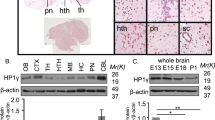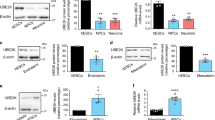Abstract
With chromatin immunoprecipitation (ChIP) and promoter DNA microarray analyses (ChIP-on-chip), we analyzed the variations of acetylation on histone H3 in all-trans retinoic acid (RA) induced neuronal cell differentiation. Neuroblastoma SH-SY5Y cells were treated with RA for 24 h and the acetylation on histone H3 in the promoter region of the genes was detected. Results showed that, after treatment, the level of acetylation on histone H3 elevated in 597 genes in the genome, and reduced in the other 647 genes compared with those of the control. In summary, we have successfully adopted a high throughput technique to detect and analyze variations of acetylation of histone H3 in human genome at the early phage of RA induced neuronal differentiation of the SH-SY5Y cells.
Similar content being viewed by others
References
Kornberg R D, Lorch Y. Twenty-five years of the nucleosome, fundamental particle of the eukaryote chromosome. Cell, 1999 98(3), 285–294
Berger S L. Histone modifications in transcriptional regulation. Curr Opin Genet Dev, 2002 12(2), 142–148
Wu J, Grunstein M. 25 years after the nucleosome model: chromatin modifications. Trends Biochem Sci, 2000 25(12), 619–623
Kornberg R D, Lorch Y. Chromatin-modifying and -remodeling complexes. Curr Opin Genet Dev, 1999 9(2), 148–151
Kurdistani S K, Grunstein M. Histone acetylation and deacetylation in yeast. Nat Rev Mol Cell Biol, 2003 4(4), 276–284
Toselli M, Masetto S, Rossi P, et al. Characterization of a voltagedependent calcium current in the human neuroblastoma cell line SH-SY5Y during differentiation. Eur J Neurosci, 1991 3(6), 514–522
Adachi Y, Itoh F, Yamamoto H, et al. Retinoic acids reduce matrilysin (matrix metalloproteinase 7) and inhibit tumor cell invasion in human colon cancer. Tumour Biol, 2001 22(4), 247–253
Jones-Villeneuve E M, McBurney M W, Rogers K A, et al. Retinoic acid induces embryonal carcinoma cells to differentiate into neurons and glial cells. J Cell Biol, 1982 94(2), 253–262
Hsu S L, Cheng C C, Shi Y R, et al. Proteolysis of integrin alpha5 and beta1 subunits involved in retinoic acid-induced apoptosis in human hepatoma Hep3B cells. Cancer Lett, 2001 167(2), 193–204
Kuo M H, Allis C D. In vivo cross-linking and immunoprecipitation for studying dynamic protein: DNA associations in a chromatin environment. Methods, 1999 19(3), 425–433
Li Z Y, Yang J, Gao X, et al. Sequential recruitment of PCAF and BRG1 contributes to myogenin activation in 12-O-tetradecanoylphorbol-13-acetate-induced early differentiation of rhabdomyosarcoma-derived cells. J Biol Chem, 2007 282(26), 18872–18878
Zhang Y, Wang J S, Chen L L, et al. Repression of hsp90beta gene by p53 in UV irradiation-induced apoptosis of Jurkat cells. J Biol Chem, 2004 279(41), 42545–42551
Garcia-Bassets I, Kwon Y S, Telese F, et al. Histone methylation-dependent mechanisms impose ligand dependency for gene activation by nuclear receptors. Cell, 2007 128(3), 505–518
Matthay K K, Villablanca J G, Seeger R C, et al. Treatment of high-risk neuroblastoma with intensive chemotherapy, radiotherapy, autologous bone marrow transplantation, and 13-cis-retinoic acid. Children’s Cancer Group. N Engl J Med, 1999 341(16), 1165–1173
Dragnev K H, Rigas J R, Dmitrovsky E. The retinoids and cancer prevention mechanisms. Oncologist, 2000 5(5), 361–368
Halfter H, Lotfi R, Westermann R, et al. Inhibition of growth and induction of differentiation of glioma cell lines by oncostatin M (OSM). Growth Factors, 1998 15(2), 135–147
Cheung W M, Chu P W, Lung C H, et al. Expression of retinoid receptors during the retinoic acid-induced neuronal differentiation of human embryonal carcinoma cells. J Neurochem, 2000 75(1), 34–40
De los Santos M, Zambrano A, Sanchez-Pacheco A, et al. Histone deacetylase inhibitors regulate retinoic acid receptor beta expression in neuroblastoma cells by both transcriptional and posttranscriptional mechanisms. Mol Endocrinol, 2007 21(10), 2416–2426
Rosewicz S, Brembeck F, Kaiser A, et al. Differential growth regulation by all-trans retinoic acid is determined by protein kinase C alpha in human pancreatic carcinoma cells. Endocrinology, 1996 137(8), 3340–3347
Megee P C, Morgan B A, Mittman B A, et al. Genetic analysis of histone H4: essential role of lysines subject to reversible acetylation. Science, 1990 247(4944), 841–845
Kuo M H, Allis C D. Roles of histone acetyltransferases and deacetylases in gene regulation. Bioessays, 1998 20(8), 615–626
Author information
Authors and Affiliations
Corresponding authors
Additional information
Supported by National Natural Science Foundation of China (Grant Nos. 90408007 and 30721063) and National Key Basic Research and Development Program of China (Grant No. 2004CB518605)
About this article
Cite this article
Fang, H., Mi, Y., Wu, N. et al. Genome-wide distribution of histone H3 acetylation in all-trans retinoic acid induced neuronal differentiation of SH-SY5Y cells. Chin. Sci. Bull. 54, 1043–1049 (2009). https://doi.org/10.1007/s11434-009-0109-3
Received:
Accepted:
Published:
Issue Date:
DOI: https://doi.org/10.1007/s11434-009-0109-3




